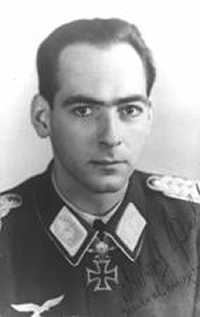Dietrich Peltz | |
|---|---|
 Dietrich Peltz | |
| Born | 9 June 1914 Gera, German Empire |
| Died | 10 August 2001 (aged 87) Munich, Germany |
| Allegiance | |
| Service | Army (1934–35) Luftwaffe (1935–45) |
| Years of service | 1934–45 |
| Rank | Generalmajor (Brigadier General) |
| Unit | StG 2, StG 77, KG 77 |
| Commands | IX. Fliegerkorps II. Jagdkorps I. Fliegerkorps |
| Battles / wars | |
| Awards | Knight's Cross of the Iron Cross with Oak Leaves and Swords |
| Relations | Hans-Karl Stepp (brother in law) |
| Other work | worked for Krupp and Telefunken |
Dietrich Peltz (9 June 1914 – 10 August 2001) was a German World War II Luftwaffe bomber pilot and youngest general of the Wehrmacht. As a pilot he flew approximately 320 combat missions, including roughly 130 as a bomber pilot on the Eastern Front, 90 as a bomber pilot on the Western Front, and 102 as a dive bomber pilot during the invasion of Poland and Battle of France.[1]
Born in Gera, Peltz joined the Reichswehr, later renamed the Wehrmacht, of Nazi Germany in 1934. Initially serving in the Heer (Army), he transferred to the Luftwaffe (Air Force) in 1935. He flew combat missions over Poland and France as a dive bomber pilot. He then converted to the Junkers Ju 88 bomber and was assigned to Kampfgeschwader 77 (KG 77—77th Bomber Wing). With this unit he flew further combat missions in the Battle of Britain. He was awarded the Knight's Cross of the Iron Cross on 14 October 1940. During Operation Barbarossa, the German invasion of the Soviet Union, Peltz was instrumental in developing bombing techniques which allowed precision bombing attacks. This achievement earned him the Knight's Cross of the Iron Cross with Oak Leaves on 31 December 1941. He was then posted to a bomber unit leaders school before he was tasked to form a unit, I. Gruppe (1st group) of Kampfgeschwader 60 (KG 60—60th Bomber Wing), specialized in the use of precision-guided munitions against Allied shipping.
In early 1943, Peltz was appointed Inspector of Combat Flight, a role in which he oversaw the strategic development of the German bomber arm. As of August 1943, he was appointed commanding general of the IX. Fliegerkorps (9th Air Corps) and was tasked with reviving the German bomber offensive as Angriffsführer England (attack leader England) against Britain and was awarded the Knight's Cross of the Iron Cross with Oak Leaves and Swords on 23 July 1943 for his leadership. This initiative lead to a night-time strategic bombing campaign against southern England code-named Operation Steinbock, which ended in heavy losses for German bombers in early 1944. Although a bomber expert, he was appointed commanding general of the II. Jagdkorps (2nd Fighter Corps) and was responsible for the planning of the unsuccessful Operation Bodenplatte, the attack of German fighters on Allied air bases in Belgium and the Netherlands. He was tasked with the entire aerial Defense of the Reich in March 1945 and advocated the idea of "ramming" to halt the air campaign against Germany even at the risk of sustaining high losses. His last service position was commanding general of I. Fliegerkorps (1st Air Corps). After the war he worked for Krupp and Telefunken and died on 10 August 2001 in Munich.
- ^ Obermaier 1976, p. 41.